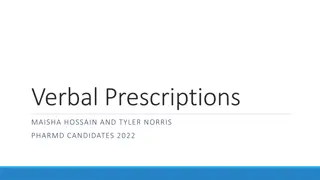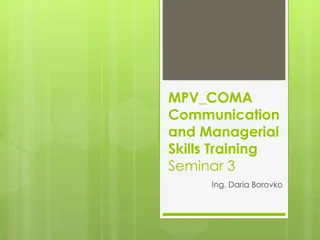GRE Verbal Section Strategies and Question Types
Explore key strategies for tackling the GRE Verbal section, including tips for Reading Comprehension and Text Completion questions. Learn about question formats, answer choices, and effective approaches to boost your performance in this test.
Download Presentation

Please find below an Image/Link to download the presentation.
The content on the website is provided AS IS for your information and personal use only. It may not be sold, licensed, or shared on other websites without obtaining consent from the author.If you encounter any issues during the download, it is possible that the publisher has removed the file from their server.
You are allowed to download the files provided on this website for personal or commercial use, subject to the condition that they are used lawfully. All files are the property of their respective owners.
The content on the website is provided AS IS for your information and personal use only. It may not be sold, licensed, or shared on other websites without obtaining consent from the author.
E N D
Presentation Transcript
Verbal GRE Section There are approximately Ten (10) Reading Comprehension Six (6) Text Completion Four (4) Sentence Equivalence
Text Completion Passage composed of one to five sentences with one to three blanks One blank = five choices Two or three blanks = three choices There is a single correct answer for each blank The answer choices for different blanks function independently You receive no credit for partially correct answers
Text Completion Basic Strategy Read through the passage Look for trigger words Ignore the given choices Formulate your own answer (Ignore the answer provided by ETS cover the answers at first. Really. Use process of elimination (POE) with sketch pad.
Although it does contain some pioneering ideas, one would hardly characterize the work as __________. A. orthodox B. eccentric C. original D. trifling E. conventional F. innovative
It is refreshing to read a book about our planet by an author who does not allow facts to be (i)__________ by politics: well aware of the political disputes about the effects of human activities on climate and biodiversity, this author does not permit them to (ii)__________ his comprehensive description of what we know about our biosphere. He emphasizes the enormous gaps in our knowledge, the sparseness of our observations, and the (iii)__________, calling attention to the many aspects of planetary evolution that must be better understood before we can accurately diagnose the condition of our planet. Blank (ii) Blank (ii) Blank (iii) (D) clouded (D) enhance (G) plausibility of our hypotheses (E) influenced (E) obscure (H) certainty of our entitlement (F) fed (F) underscore (I) superficiality of our theories
Tips for Text Completion Find a story. The previous text completion task was a story about _________? Get your scratch paper ready (put your own words in next to the subscript at the top and look for the words that match. Use POE! i (rigorous) ii (always) iii (above) A A A B B C C C
Reading Comprehension Three types of questions 1. Multiple choice (five choices) 2. Select all that apply (three choices) 3. Select in passage
Reading Comprehension Each question is based on a passage about ten passages on test between one and several paragraphs long majority are one paragraph
Slow Down This is the section that will take more of your time Practice your best strategy for giving yourself time for Reading Comprehension. e.g. Get faster at text completion and sentence equivalence. Be smart (mindful) about where you spend your time. Practice, practice, so you know best how to give yourself time to get Reading Comprehension right.
Be Aware (mindful) Get a good feeling for the meaning of the passage. Some of the answers ETS provides will make sense in the passage, but don t answer the question they ask. Answer choices are carefully designed to mislead. Always go back to the passage to find support for your answer.
Figure How to Maximize Your Time How much time should you spend on answering? Use the 2-1-1-F method. Read the first two sentences in a passage, the first sentence of each paragraph, and the last sentence of the passage. This will give you a sense of the passage. Then move to the questions.
Reviving the practice of using elements of popular music in classical composition, an approach that had been in hibernation in the United States during the 1960s, composer Philip Glass (born 1937) embraced the ethos of popular music in his compositions. Glass based two symphonies on music by rock musicians David Bowie and Brian Eno, but the symphonies' sound is distinctively his. Popular elements do not appear out of place in Glass's classical music, which from its early days has shared certain harmonies and rhythms with rock music. Yet this use of popular elements has not made Glass a composer of popular music. His music is not a version of popular music packaged to attract classical listeners; it is high art for listeners steeped in rock rather than the classics.
Reviving the practice of using elements of popular music in classical composition, an approach that had been in hibernation in the United States during the 1960s, composer Philip Glass (born 1937) embraced the ethos of popular music in his compositions. Glass based two symphonies on music by rock musicians David Bowie and Brian Eno, but the symphonies' sound is distinctively his. Popular elements do not appear out of place in Glass's classical music, which from its early days has shared certain harmonies and rhythms with rock music. Yet this use of popular elements has not made Glass a composer of popular music. His music is not a version of popular music packaged to attract classical listeners; it is high art for listeners steeped in rock rather than the classics. Select only one answer choice. The passage addresses which of the following issues related to Glass's use of popular elements in his classical compositions? A. How it is regarded by listeners who prefer rock to the classics B. How it has affected the commercial success of Glass's music C. Whether it has contributed to a revival of interest among other composers in using popular elements in their compositions D. Whether it has had a detrimental effect on Glass's reputation
Sentence Equivalence Approximately eight (8) total questions; four (4) per section Questions consist of: One sentence One blank Six answer choices
Select the two answer choices that, when used to complete the sentence, fit the meaning of the sentence as a whole and produce completed sentences that are alike in meaning. In other words, figure out the story being told and pick the two words that will complete the story in the same way. no credit for partially correct answers.
Tips for Answering Tips for Answering Read the sentence to get an overall sense Read the sentence to get an overall sense Identify significant words or phrases elimination Identify significant words or phrases Formulate your own response Compare your answer; use process of Formulate your own response Compare your answer; use process of elimination Double check your answers Double check your answers
Newspapers report that the former executive has been trying to keep a low profile since his _______ exit from the company A. celebrated B. mysterious C. long-awaited D. fortuitous E. indecorous F. unseemly
Newspapers report that the former executive has been trying to keep a low profile since his _______ exit from the company Before you do anything, decide what story is being told. Cover the answer choices. Come up with your own words. Use POE (does the answer mean the same as my word?). Use your scratch pad!
Newspapers report that the former executive has been trying to keep a low profile since his _______ exit from the company What two words you would use? Bad? Terrible? What words fit your words? A. celebrated A B. mysterious B (no simile in group ) C. long-awaited C (^^) D. fortuitous D E. indecorous E ? (what is this?) F. unseemly F
Make Sure to Use Your Scratch Paper! These are only introductions to the verbal section and brief strategies for addressing them. However, the key to getting through these questions is to use your scratch paper.























